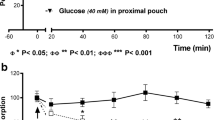Summary
The effects of clonidine on gastric acid secretion were studied in conscious dogs wih both gastric fistulae and Heidenhain pouches. Clonidine infused systemically at graded doses under basal conditions produced a significant increase in acid secretion from both gastric fistulae and Heidenhain pouches. Acid secretion from gastric fistulae submaximally stimulated by pentagastrin was dose-dependently reduced by clonidine while 2-deoxy-d-glucose-induced secretion was completely suppressed. Under these conditions a significant enhancement of secretion from Heidenhain pouches was recorded. An increase in acid secretion from both main stomachs and Heidenhain pouches was observed for clonidine with submaximal doses of bethanechol and histamine as stimulants, though clonidine showed no effect on maximal stimulation by histamine. The stimulant effect of clonidine from gastric fistulae and Heidenhain pouches under basal conditions was fully prevented by cimetidine, while the inhibitory effect of clonidine on acid secretion stimulated by pentagastrin from gastric fistulae was reversed by yohimbine.
The present results suggest that clonidine displays two simultaneous yet opposite effects on dog gastric secretion. The inhibitory effect might be mediated through a decrease of vagally released acetylcholine following the activation of alpha2-adrenoceptors both at central and peripheral sites, while the stimulatory effect probably depends on the histamine-like properties of the drug.
Similar content being viewed by others
References
Andréjak M, Pommier Y, Mouillé P, Schmitt H (1980) Effects of some alpha-adrenoceptor agonists and antagonists on the guinea-pig ileum. Naunyn-Schmiedeberg's Arch Pharmacol 314:83–87
Cheng HC, Gleason EM, Nathan BA, Lachmann PJ, Woodward JK (1981) Effects of clonidine on gastric acid secretion in the rat. J Pharmacol Exp Ther 217:121–126
Curwain BP, Endersby K (1974) Enhancement of pentagastrin-induced gastric acid secretion by clonidine in the conscious dog. Br J Pharmacol 50:431–434
Del Tacca M, Soldani G, Bernardini C, Martinotti E, Impicciatore M (1982) Pharmacological studies on the mechanisms underlying the inhibitory and excitatory effects of clonidine on gastric acid secretion. Eur J Pharmacol 81:255–261
Eisenberg MM, Emas GS, Grossman MI (1966) Comparison of the effect of 2-deoxy-d-glucose and insulin on gastric acid secretion in dogs. Surgery 60:111–117
Hoefke W, Kobinger W (1966) Pharmakologische Wirkungen des 2-(2,6-Dichlorphenylamino)-2-imidazolin-hydrochlorids, einer neuen antihypertensiven Substanz. Arzneim Forsch 16:1038–1050
Jadhav JH, Balsara JJ, Chandorkar AG (1983) Involvement of histaminergic mechanisms in the cataleptogenic effect of clonidine in mice. J Pharm Pharmacol 35:671–673
Jennewein HM (1977) The effect of clonidine on gastric acid secretion in rats and dogs. Naunyn-Schmiedeberg's Arch Pharmacol 297:85–90
Kaess H, von Mickulicz-Radecki J (1971) The influence of 2-(2,6 dichlorophenylamino)-2-imiddazoline hydrochloride (Catapresan) on the function of the stomach and pancreas. Eur J Clin Pharmacol 3:97–101
Kobinger W (1978) Central alpha-adrenergic system as target for hypotensive drugs. Rev Physiol Biochem Pharmacol 81:39–100
Magee DF (1975) Action of morphine sulphate on stimulated gastric secretion in dogs. Gastroenterology 68:1340–1343
Medgett IC, McCulloch MW (1980) Receptor sites of action of clonidine and three structural isomers on prejunctional and postjunctional alpha-adrenoceptors and histamine H2-receptors in guinea-pig cardiovascular tissues. J Pharm Pharmacol 32:137–138
Ottenjann R (1968) Sekretion, Motilität und Schleimbautdurchblutung des Magens unter dem Einfluß von Dichlorphenylamino-imidazolin. In: Heilmeyer L, Holtmeyer HJ, Pfeiffer EF (eds) Hochdrucktherapie. Thieme, Stuttgart, pp 202–205
Parsons ME (1978) Studies on the effect of clonidine on histamine H2-receptors in the uterus, heart and gastric mucosa. Agents Actions 8:402–403
Pascaud X, Roger A, Genton M, Rozè C (1983) Further support for the central origin of the gastric antisecretory properties of clonidine in conscious rats. Eur J Pharmacol 86:247–257
Starke K (1981) Alpha-adrenoceptor subclassification. Rev Physiol Biochem Pharmacol 88:199–236
Walz A, Van Zwieten PA (1970) The influence of 2-(2,6-dichlorophenylamino)-2-imidazoline hydrochloride (clonidine) and some related compounds on gastric secretion in the anaesthetized rat. Eur J Pharmacol 10:369–377
Author information
Authors and Affiliations
Rights and permissions
About this article
Cite this article
Soldani, G., Del Tacca, M., Bernardini, C. et al. Evidence for two opposite effects of clonidine on gastric acid secretion in the dog. Naunyn-Schmiedeberg's Arch. Pharmacol. 327, 139–142 (1984). https://doi.org/10.1007/BF00500908
Received:
Accepted:
Issue Date:
DOI: https://doi.org/10.1007/BF00500908



